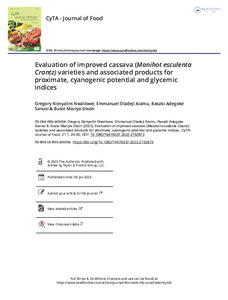| dc.contributor.author | Nwaoliwe, G. |
| dc.contributor.author | Alamu, E.O. |
| dc.contributor.author | Sanusi, R. |
| dc.contributor.author | Maziya-Dixon, B. |
| dc.date.accessioned | 2023-03-16T09:27:42Z |
| dc.date.available | 2023-03-16T09:27:42Z |
| dc.date.issued | 2023-01-05 |
| dc.identifier.citation | Nwaoliwe, G., Alamu, E.O., Sanusi, R. & Maziya-Dixon, B. (2023). Evaluation of improved cassava (Manihot esculenta Crantz) varieties and associated products for proximate, cyanogenic potential and glycemic indices. CyTA-Journal of Food, 21(1), 20-30. |
| dc.identifier.issn | 1947-6337 |
| dc.identifier.uri | https://hdl.handle.net/20.500.12478/8093 |
| dc.description.abstract | This study investigated the proximate, cyanide, and glycemic indices of roots and eba (gari dough) made from improved cassava cultivars. Twenty cassava cultivars were obtained from the IITA research farms and analyzed for proximate and carbohydrate compositions and cyanogenic potential using standard procedures. Afterward, four cassava varieties were selected using the agglomerate hierarchical cluster analysis. The selected varieties were processed into gari and reconstituted in hot water into eba, and the glycemic indices(GIs) of the four eba samples were determined in apparently 23 healthy volunteers. The starch content of the selected varieties was 69.1% for IITATMEB7419, 71.6% for TMSIBA980505, 72.7% for TMSIBA981089A, and 74.5% for TMSIBA980002. The ratios of starch to sugar were significantly (p > 0.05) comparable for all the samples. The GIs obtained for the four eba samples were 88.1% for TMSIBA980002; 87.2% for TMS980505; 84.4% for TMEB7419, and 89.1% for TMS IBA961089A. |
| dc.format.extent | 20-30 |
| dc.language.iso | en |
| dc.subject | Carbohydrates |
| dc.subject | Garri |
| dc.subject | Hyperglycaemia |
| dc.subject | Varieties |
| dc.title | Evaluation of improved cassava (Manihot esculenta Crantz) varieties and associated products for proximate, cyanogenic potential and glycemic indices |
| dc.type | Journal Article |
| cg.contributor.crp | Agriculture for Nutrition and Health |
| cg.contributor.crp | Maize |
| cg.contributor.crp | Roots, Tubers and Bananas |
| cg.contributor.affiliation | International Institute of Tropical Agriculture |
| cg.contributor.affiliation | University of Ibadan |
| cg.coverage.region | Africa |
| cg.coverage.region | West Africa |
| cg.coverage.country | Nigeria |
| cg.coverage.hub | Southern Africa Hub |
| cg.coverage.hub | Headquarters and Western Africa Hub |
| cg.researchtheme | Nutrition and Human Health |
| cg.identifier.bibtexciteid | NWAOLIWE:2023 |
| cg.isijournal | ISI Journal |
| cg.authorship.types | CGIAR and developing country institute |
| cg.iitasubject | Cassava |
| cg.iitasubject | Food Security |
| cg.iitasubject | Nutrition |
| cg.iitasubject | Value Chains |
| cg.journal | CyTA-Journal of Food |
| cg.notes | Open Access Article; Published online: 05 Jan 2023 |
| cg.accessibilitystatus | Open Access |
| cg.reviewstatus | Peer Review |
| cg.usagerightslicense | Creative Commons Attribution 4.0 (CC BY 0.0) |
| cg.targetaudience | Scientists |
| cg.iitaauthor.identifier | Alamu Emmanuel Oladeji: 0000-0001-6263-1359 |
| cg.iitaauthor.identifier | Busie Maziya-Dixon: 0000-0003-2014-2201 |
| cg.futureupdate.required | No |
| cg.identifier.issue | 1 |
| cg.identifier.volume | 21 |

